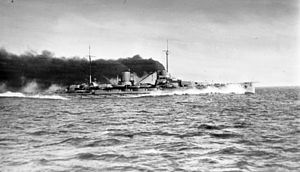Ottoman battlecruiser Yavûz Sultân Selîm

SMS Goeben
|
|
| History | |
|---|---|
|
|
|
| Name: | Goeben |
| Namesake: | August Karl von Goeben |
| Ordered: | 8 April 1909 |
| Builder: | Blohm & Voss, Hamburg |
| Laid down: | 28 August 1909 |
| Launched: | 28 March 1911 |
| Commissioned: | 2 July 1912 |
| Fate: | Transferred to the Ottoman Empire 16 August 1914 |
|
|
|
| Name: | Yavuz Sultan Selim |
| Namesake: | Selim I |
| Acquired: | 16 August 1914 |
| Commissioned: | 16 August 1914 |
| Decommissioned: | 20 December 1950 |
| Renamed: | Yavuz in 1936 |
| Struck: | 14 November 1954 |
| Fate: | Scrapped in 1973 |
| General characteristics | |
| Class and type: | Moltke-class battlecruiser |
| Displacement: |
|
| Length: | 186.6 m (612 ft 2 in) |
| Beam: | 30 m (98 ft 5 in) |
| Draft: | 9.2 m (30 ft 2 in) |
| Installed power: | |
| Propulsion: | 4 screws, Parsons steam turbines |
| Speed: |
|
| Range: | 4,120 nmi (7,630 km; 4,740 mi) at 14 kn (26 km/h; 16 mph) |
| Complement: |
|
| Armament: |
|
| Armor: |
|
SMS Goeben was the second of two Moltke-class battlecruisers of the Imperial German Navy, launched in 1911 and named after the German Franco-Prussian War veteran General August Karl von Goeben. Along with her sister ship, Goeben was similar to the previous German battlecruiser design, Von der Tann, but larger, with increased armor protection and two more main guns in an additional turret. Goeben and Moltke were significantly larger and better armored than the comparable British Indefatigable class.
Several months after her commissioning in 1912, Goeben, with the light cruiser Breslau, formed the German Mediterranean Division and patrolled there during the Balkan Wars. After the outbreak of World War I on 28 July 1914, Goeben and Breslau bombarded French positions in North Africa and then evaded British naval forces in the Mediterranean and reached Constantinople. The two ships were transferred to the Ottoman Empire on 16 August 1914, and Goeben became the flagship of the Ottoman Navy as Yavuz Sultan Selim, usually shortened to Yavuz. By bombarding Russian facilities in the Black Sea, she brought Turkey into World War I on the German side. The ship operated primarily against Russian forces in the Black Sea during the war, including several inconclusive engagements with Russian battleships. She made a sortie into the Aegean in January 1918 that resulted in the Battle of Imbros, where Yavuz sank a pair of British monitors but was herself badly damaged by mines.
...
Wikipedia
